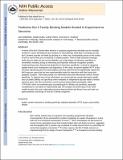| dc.contributor.author | Dutta, Sanjib | |
| dc.contributor.author | Reich, Lothar | |
| dc.contributor.author | Keating, Amy E. | |
| dc.contributor.author | DeBartolo, Joseph Vincent | |
| dc.date.accessioned | 2014-01-31T17:00:23Z | |
| dc.date.available | 2014-01-31T17:00:23Z | |
| dc.date.issued | 2012-05 | |
| dc.date.submitted | 2012-05 | |
| dc.identifier.issn | 00222836 | |
| dc.identifier.issn | 1089-8638 | |
| dc.identifier.uri | http://hdl.handle.net/1721.1/84621 | |
| dc.description.abstract | Proteins of the Bcl-2 family either enhance or suppress programmed cell death and are centrally involved in cancer development and resistance to chemotherapy. BH3 (Bcl-2 homology 3)-only Bcl-2 proteins promote cell death by docking an α-helix into a hydrophobic groove on the surface of one or more of five pro-survival Bcl-2 receptor proteins. There is high structural homology within the pro-death and pro-survival families, yet a high degree of interaction specificity is nevertheless encoded, posing an interesting and important molecular recognition problem. Understanding protein features that dictate Bcl-2 interaction specificity is critical for designing peptide-based cancer therapeutics and diagnostics. In this study, we present peptide SPOT arrays and deep sequencing data from yeast display screening experiments that significantly expand the BH3 sequence space that has been experimentally tested for interaction with five human anti-apoptotic receptors. These data provide rich information about the determinants of Bcl-2 family specificity. To interpret and use the information, we constructed two simple data-based models that can predict affinity and specificity when evaluated on independent data sets within a limited sequence space. We also constructed a novel structure-based statistical potential, called STATIUM, which is remarkably good at predicting Bcl-2 affinity and specificity, especially considering it is not trained on experimental data. We compare the performance of our three models to each other and to alternative structure-based methods and discuss how such tools can guide prediction and design of new Bcl-2 family complexes. | en_US |
| dc.description.sponsorship | National Institutes of Health (U.S.) (Award GM067681) | en_US |
| dc.description.sponsorship | National Science Foundation (U.S.) (Grant 0821391) | en_US |
| dc.language.iso | en_US | |
| dc.publisher | Elsevier | en_US |
| dc.relation.isversionof | http://dx.doi.org/10.1016/j.jmb.2012.05.022 | en_US |
| dc.rights | Creative Commons Attribution-Noncommercial-Share Alike 3.0 | en_US |
| dc.rights.uri | http://creativecommons.org/licenses/by-nc-sa/3.0/ | en_US |
| dc.source | PMC | en_US |
| dc.title | Predictive Bcl-2 Family Binding Models Rooted in Experiment or Structure | en_US |
| dc.type | Article | en_US |
| dc.identifier.citation | DeBartolo, Joe, Sanjib Dutta, Lothar Reich, and Amy E. Keating. “Predictive Bcl-2 Family Binding Models Rooted in Experiment or Structure.” Journal of Molecular Biology 422, no. 1 (September 2012): 124-144. | en_US |
| dc.contributor.department | Massachusetts Institute of Technology. Department of Biology | en_US |
| dc.contributor.mitauthor | DeBartolo, Joseph Vincent | en_US |
| dc.contributor.mitauthor | Dutta, Sanjib | en_US |
| dc.contributor.mitauthor | Reich, Lothar | en_US |
| dc.contributor.mitauthor | Keating, Amy E. | en_US |
| dc.relation.journal | Journal of Molecular Biology | en_US |
| dc.eprint.version | Author's final manuscript | en_US |
| dc.type.uri | http://purl.org/eprint/type/JournalArticle | en_US |
| eprint.status | http://purl.org/eprint/status/PeerReviewed | en_US |
| dspace.orderedauthors | DeBartolo, Joe; Dutta, Sanjib; Reich, Lothar; Keating, Amy E. | en_US |
| dc.identifier.orcid | https://orcid.org/0000-0003-4074-8980 | |
| mit.license | OPEN_ACCESS_POLICY | en_US |
| mit.metadata.status | Complete | |
